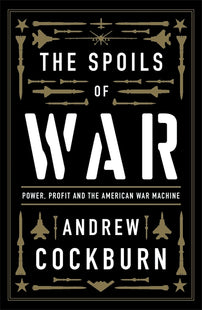The Ukrainian ‘Gold Rush’
“The imperative of the US military-industrial complex is not to prepare for war, but to perpetuate and amplify the flow of public money in its direction.”

For the US military-industrial complex, the Ukraine war came as a blessing only slightly marred by incontestable evidence that Putin’s military, previously billed as an increasingly dangerous threat, was not so formidable after all. Nevertheless, the Pentagon and its congressional allies saw no reason not to respond in a traditional manner.
As House Armed Services Committee Chairman Adam Smith swiftly declared, the future military budget would be “bigger than we thought,” as Russia’s invasion of Ukraine had complicated the US security posture and impressed a greater sense of urgency for funding defense priorities.
Defense spending for 2022 of $796 billion, as projected by the Congressional Budget Office, swiftly zoomed to $828 billion, but that was rapidly eclipsed by the Senate Armed Services Committee’s authorization of $857 billion (the House Committee opted for a slightly lower figure of $850 billion, ensuring an eventual number somewhere between the two). Pentagon budget watchers confidently predicted that spending would hit $1 trillion by 2027.
The river of incoming defense cash flowed profitably onto the balance sheets of leading weapons-makers to the joy of investors. “Russia’s war in Ukraine is Escalating. It’s Time to Buy Defense Stocks,” headlined the business journal Barron’s seven months into the war, pointing out that while the overall stock market had dropped almost a quarter in the course of the year, a basket of leading defense stocks, including Lockheed Martin and Northrop Grumman, were up almost 6 percent, and still looked cheap.
In Ukraine itself, the Biden administration’s open checkbook for aid inevitably sparked what one Pentagon official called “a gold rush” among hopeful vendors. Little of the billions in military aid on offer actually went to the Ukrainians themselves. The bulk of the cash was destined for US military services, either to reimburse them for weapons drawn from their stocks, or to buy weapons that were then handed on to the Ukrainians. Insiders lamented the lack of any overall plan for fulfilling Ukraine’s needs. For months, the Pentagon failed to produce a comprehensive list of requirements, leaving weapons salesmen and lobbyists to hustle uncoordinated sales pitches.
Unsurprisingly, the systems attracting the most attention, both from the Ukrainians and in the Pentagon, were those supposedly capable of turning the tide on the battlefield. Javelin antitank missiles, Switchblade “suicide” drones, M777 howitzers, HIMARS (High-Mobility Artillery Rocket Systems) were each successively hailed as “game-changers” until, inevitably, the Russians developed counters, such as jammers for the drones or the dispersion of ammunition and fuel dumps for the HIMARS.
Strikingly, for a regional conflict far smaller in scale compared to twentieth-century European wars, the effort to sustain the Ukrainian war effort appeared to have put America’s defense resources under severe strain. For example, six months into the war, the US military claimed it had provided Ukraine with up to 806,000 rounds of 155mm ammunition for the ninety M777 howitzers rushed to Ukraine, as a result of which Pentagon officials reported that US ammunition stocks had run “dangerously low.” Similar shortages were reported for the Army’s reserves of Javelins and Stinger antiaircraft missiles.
Given the staggering amounts of money showered on the US military, the fact that support for one comparatively limited war put severe strain on basic elements of a war machine supposedly equipped to take on Russia and China simultaneously, along with ongoing engagements in Syria and elsewhere, points to a deeper truth, repeatedly addressed in this book, and discerned and forcefully described in the early 1980s by Pentagon analyst Franklin “Chuck” Spinney: the imperative of the US military-industrial complex is not to prepare for war, but to perpetuate and amplify the flow of public money in its direction, principally by means of promoting ever more expensive and complex systems of dubious utility.
The pattern is unvarying: new and allegedly more capable systems always cost more than promised. In consequence, the system is bought in smaller quantities than planned because budgets, even though constantly growing, never keep up with increased costs, so the overall size of the force steadily shrinks. The Air Force’s fighter strength, for example, declined by almost two thirds between 1999 and 2022. Furthermore, since new models never arrive in sufficient numbers, the services must keep older models in service far longer than originally projected, which of course require progressively more intensive maintenance, driving costs still higher. Half the planes flown by the US Air Force were built in the 1980s or even earlier. The Navy’s ships exhibit a similar trend. Army troop numbers steadily shrink, while the Marines are discarding their tanks and much of their artillery (which has been sent to Ukraine).
There is little prospect of change, except for the worse. Economic growth and corporate profits have clearly been driven in recent years by massive government spending, particularly in response to the economic trauma of the Covid-induced lockdowns. The prospect of divided government in Washington, with Republicans in Congress throttling Biden’s social-spending options, allows for one field of expansion where bipartisan support is assured: defense. As the US and global economy sinks into recession (driven in part by the self-inflicted damage caused by sanctions on Russian energy exports), the attractions of a war economy, driven by the private passions of so many interested parties, grow ever brighter, and more frightening.
— an excerpt from The Spoils of War: Power, Profit and the American War Machine by Andrew Cockburn
[book-strip index="1"]

